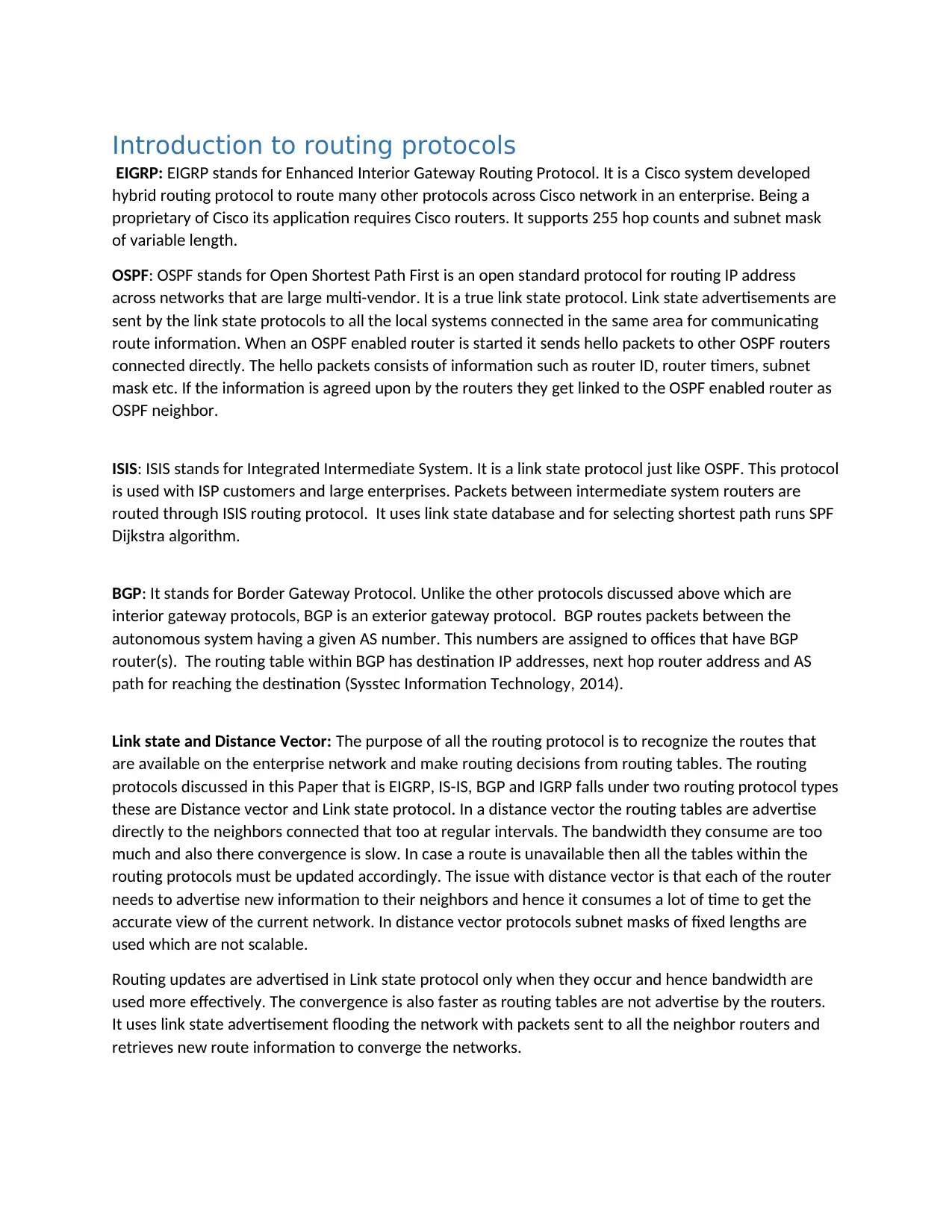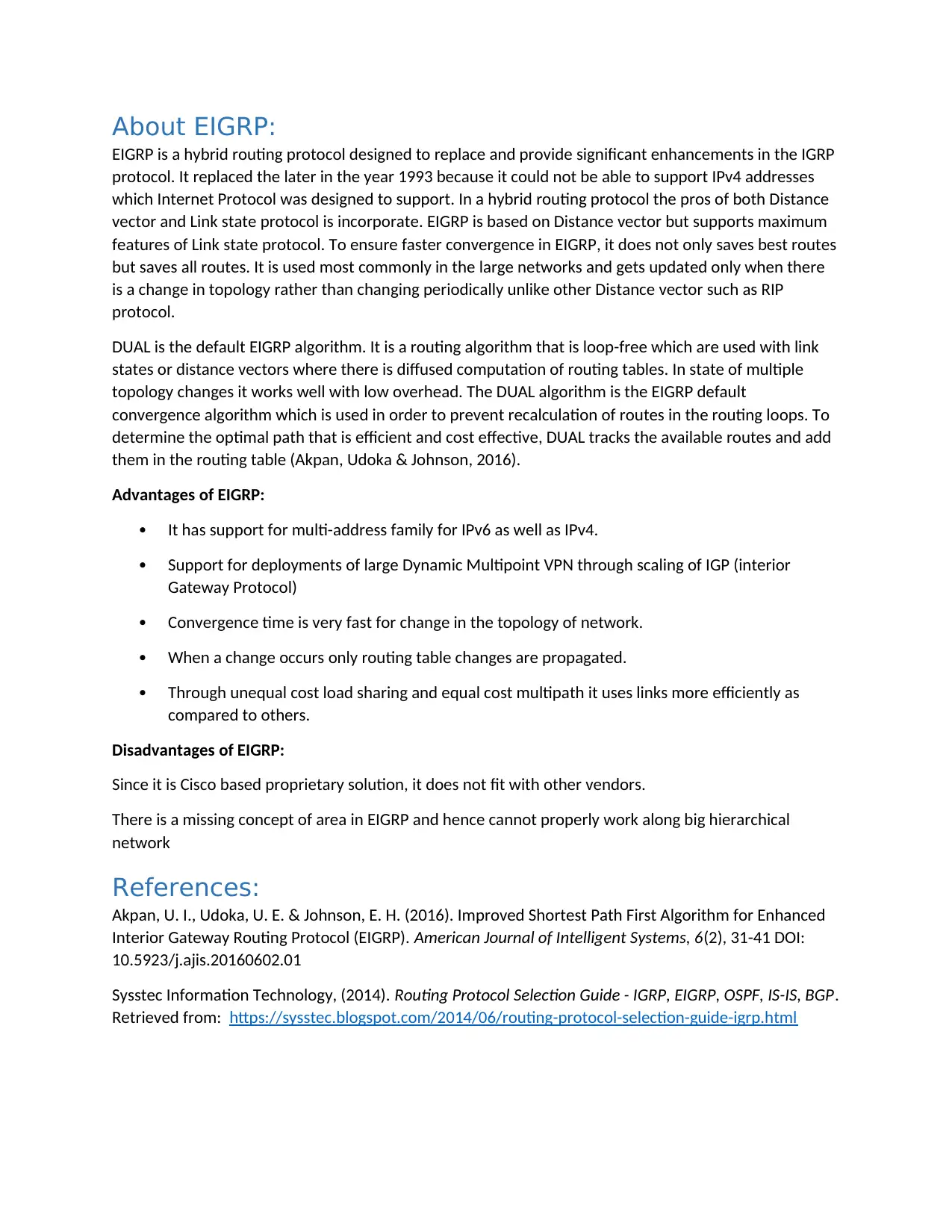Network Management: Routing Protocol Analysis - EIGRP, OSPF, ISIS, BGP
VerifiedAdded on 2023/04/20
|2
|982
|128
Report
AI Summary
This report provides a comparative analysis of several routing protocols including EIGRP, OSPF, ISIS, and BGP. EIGRP (Enhanced Interior Gateway Routing Protocol), a Cisco proprietary hybrid protocol, is contrasted with OSPF (Open Shortest Path First), an open standard link-state protocol. ISIS (Integrated Intermediate System) is also examined as another link-state protocol used in large networks. The report further details BGP (Border Gateway Protocol), an exterior gateway protocol used for routing between autonomous systems. The document differentiates between distance vector and link-state protocols, highlighting the advantages and disadvantages of each, focusing on EIGRP's hybrid approach. The analysis covers the advantages and disadvantages of EIGRP, including its fast convergence time and limited vendor compatibility. The report references academic sources to support its findings, providing a comprehensive overview of these key routing protocols.

Introduction to routing protocols
EIGRP: EIGRP stands for Enhanced Interior Gateway Routing Protocol. It is a Cisco system developed
hybrid routing protocol to route many other protocols across Cisco network in an enterprise. Being a
proprietary of Cisco its application requires Cisco routers. It supports 255 hop counts and subnet mask
of variable length.
OSPF: OSPF stands for Open Shortest Path First is an open standard protocol for routing IP address
across networks that are large multi-vendor. It is a true link state protocol. Link state advertisements are
sent by the link state protocols to all the local systems connected in the same area for communicating
route information. When an OSPF enabled router is started it sends hello packets to other OSPF routers
connected directly. The hello packets consists of information such as router ID, router timers, subnet
mask etc. If the information is agreed upon by the routers they get linked to the OSPF enabled router as
OSPF neighbor.
ISIS: ISIS stands for Integrated Intermediate System. It is a link state protocol just like OSPF. This protocol
is used with ISP customers and large enterprises. Packets between intermediate system routers are
routed through ISIS routing protocol. It uses link state database and for selecting shortest path runs SPF
Dijkstra algorithm.
BGP: It stands for Border Gateway Protocol. Unlike the other protocols discussed above which are
interior gateway protocols, BGP is an exterior gateway protocol. BGP routes packets between the
autonomous system having a given AS number. This numbers are assigned to offices that have BGP
router(s). The routing table within BGP has destination IP addresses, next hop router address and AS
path for reaching the destination (Sysstec Information Technology, 2014).
Link state and Distance Vector: The purpose of all the routing protocol is to recognize the routes that
are available on the enterprise network and make routing decisions from routing tables. The routing
protocols discussed in this Paper that is EIGRP, IS-IS, BGP and IGRP falls under two routing protocol types
these are Distance vector and Link state protocol. In a distance vector the routing tables are advertise
directly to the neighbors connected that too at regular intervals. The bandwidth they consume are too
much and also there convergence is slow. In case a route is unavailable then all the tables within the
routing protocols must be updated accordingly. The issue with distance vector is that each of the router
needs to advertise new information to their neighbors and hence it consumes a lot of time to get the
accurate view of the current network. In distance vector protocols subnet masks of fixed lengths are
used which are not scalable.
Routing updates are advertised in Link state protocol only when they occur and hence bandwidth are
used more effectively. The convergence is also faster as routing tables are not advertise by the routers.
It uses link state advertisement flooding the network with packets sent to all the neighbor routers and
retrieves new route information to converge the networks.
EIGRP: EIGRP stands for Enhanced Interior Gateway Routing Protocol. It is a Cisco system developed
hybrid routing protocol to route many other protocols across Cisco network in an enterprise. Being a
proprietary of Cisco its application requires Cisco routers. It supports 255 hop counts and subnet mask
of variable length.
OSPF: OSPF stands for Open Shortest Path First is an open standard protocol for routing IP address
across networks that are large multi-vendor. It is a true link state protocol. Link state advertisements are
sent by the link state protocols to all the local systems connected in the same area for communicating
route information. When an OSPF enabled router is started it sends hello packets to other OSPF routers
connected directly. The hello packets consists of information such as router ID, router timers, subnet
mask etc. If the information is agreed upon by the routers they get linked to the OSPF enabled router as
OSPF neighbor.
ISIS: ISIS stands for Integrated Intermediate System. It is a link state protocol just like OSPF. This protocol
is used with ISP customers and large enterprises. Packets between intermediate system routers are
routed through ISIS routing protocol. It uses link state database and for selecting shortest path runs SPF
Dijkstra algorithm.
BGP: It stands for Border Gateway Protocol. Unlike the other protocols discussed above which are
interior gateway protocols, BGP is an exterior gateway protocol. BGP routes packets between the
autonomous system having a given AS number. This numbers are assigned to offices that have BGP
router(s). The routing table within BGP has destination IP addresses, next hop router address and AS
path for reaching the destination (Sysstec Information Technology, 2014).
Link state and Distance Vector: The purpose of all the routing protocol is to recognize the routes that
are available on the enterprise network and make routing decisions from routing tables. The routing
protocols discussed in this Paper that is EIGRP, IS-IS, BGP and IGRP falls under two routing protocol types
these are Distance vector and Link state protocol. In a distance vector the routing tables are advertise
directly to the neighbors connected that too at regular intervals. The bandwidth they consume are too
much and also there convergence is slow. In case a route is unavailable then all the tables within the
routing protocols must be updated accordingly. The issue with distance vector is that each of the router
needs to advertise new information to their neighbors and hence it consumes a lot of time to get the
accurate view of the current network. In distance vector protocols subnet masks of fixed lengths are
used which are not scalable.
Routing updates are advertised in Link state protocol only when they occur and hence bandwidth are
used more effectively. The convergence is also faster as routing tables are not advertise by the routers.
It uses link state advertisement flooding the network with packets sent to all the neighbor routers and
retrieves new route information to converge the networks.
Paraphrase This Document
Need a fresh take? Get an instant paraphrase of this document with our AI Paraphraser

About EIGRP:
EIGRP is a hybrid routing protocol designed to replace and provide significant enhancements in the IGRP
protocol. It replaced the later in the year 1993 because it could not be able to support IPv4 addresses
which Internet Protocol was designed to support. In a hybrid routing protocol the pros of both Distance
vector and Link state protocol is incorporate. EIGRP is based on Distance vector but supports maximum
features of Link state protocol. To ensure faster convergence in EIGRP, it does not only saves best routes
but saves all routes. It is used most commonly in the large networks and gets updated only when there
is a change in topology rather than changing periodically unlike other Distance vector such as RIP
protocol.
DUAL is the default EIGRP algorithm. It is a routing algorithm that is loop-free which are used with link
states or distance vectors where there is diffused computation of routing tables. In state of multiple
topology changes it works well with low overhead. The DUAL algorithm is the EIGRP default
convergence algorithm which is used in order to prevent recalculation of routes in the routing loops. To
determine the optimal path that is efficient and cost effective, DUAL tracks the available routes and add
them in the routing table (Akpan, Udoka & Johnson, 2016).
Advantages of EIGRP:
It has support for multi-address family for IPv6 as well as IPv4.
Support for deployments of large Dynamic Multipoint VPN through scaling of IGP (interior
Gateway Protocol)
Convergence time is very fast for change in the topology of network.
When a change occurs only routing table changes are propagated.
Through unequal cost load sharing and equal cost multipath it uses links more efficiently as
compared to others.
Disadvantages of EIGRP:
Since it is Cisco based proprietary solution, it does not fit with other vendors.
There is a missing concept of area in EIGRP and hence cannot properly work along big hierarchical
network
References:
Akpan, U. I., Udoka, U. E. & Johnson, E. H. (2016). Improved Shortest Path First Algorithm for Enhanced
Interior Gateway Routing Protocol (EIGRP). American Journal of Intelligent Systems, 6(2), 31-41 DOI:
10.5923/j.ajis.20160602.01
Sysstec Information Technology, (2014). Routing Protocol Selection Guide - IGRP, EIGRP, OSPF, IS-IS, BGP.
Retrieved from: https://sysstec.blogspot.com/2014/06/routing-protocol-selection-guide-igrp.html
EIGRP is a hybrid routing protocol designed to replace and provide significant enhancements in the IGRP
protocol. It replaced the later in the year 1993 because it could not be able to support IPv4 addresses
which Internet Protocol was designed to support. In a hybrid routing protocol the pros of both Distance
vector and Link state protocol is incorporate. EIGRP is based on Distance vector but supports maximum
features of Link state protocol. To ensure faster convergence in EIGRP, it does not only saves best routes
but saves all routes. It is used most commonly in the large networks and gets updated only when there
is a change in topology rather than changing periodically unlike other Distance vector such as RIP
protocol.
DUAL is the default EIGRP algorithm. It is a routing algorithm that is loop-free which are used with link
states or distance vectors where there is diffused computation of routing tables. In state of multiple
topology changes it works well with low overhead. The DUAL algorithm is the EIGRP default
convergence algorithm which is used in order to prevent recalculation of routes in the routing loops. To
determine the optimal path that is efficient and cost effective, DUAL tracks the available routes and add
them in the routing table (Akpan, Udoka & Johnson, 2016).
Advantages of EIGRP:
It has support for multi-address family for IPv6 as well as IPv4.
Support for deployments of large Dynamic Multipoint VPN through scaling of IGP (interior
Gateway Protocol)
Convergence time is very fast for change in the topology of network.
When a change occurs only routing table changes are propagated.
Through unequal cost load sharing and equal cost multipath it uses links more efficiently as
compared to others.
Disadvantages of EIGRP:
Since it is Cisco based proprietary solution, it does not fit with other vendors.
There is a missing concept of area in EIGRP and hence cannot properly work along big hierarchical
network
References:
Akpan, U. I., Udoka, U. E. & Johnson, E. H. (2016). Improved Shortest Path First Algorithm for Enhanced
Interior Gateway Routing Protocol (EIGRP). American Journal of Intelligent Systems, 6(2), 31-41 DOI:
10.5923/j.ajis.20160602.01
Sysstec Information Technology, (2014). Routing Protocol Selection Guide - IGRP, EIGRP, OSPF, IS-IS, BGP.
Retrieved from: https://sysstec.blogspot.com/2014/06/routing-protocol-selection-guide-igrp.html
1 out of 2
Related Documents
Your All-in-One AI-Powered Toolkit for Academic Success.
+13062052269
info@desklib.com
Available 24*7 on WhatsApp / Email
![[object Object]](/_next/static/media/star-bottom.7253800d.svg)
Unlock your academic potential
Copyright © 2020–2025 A2Z Services. All Rights Reserved. Developed and managed by ZUCOL.




